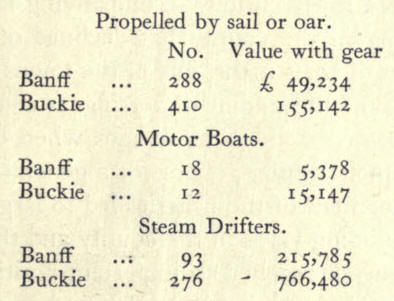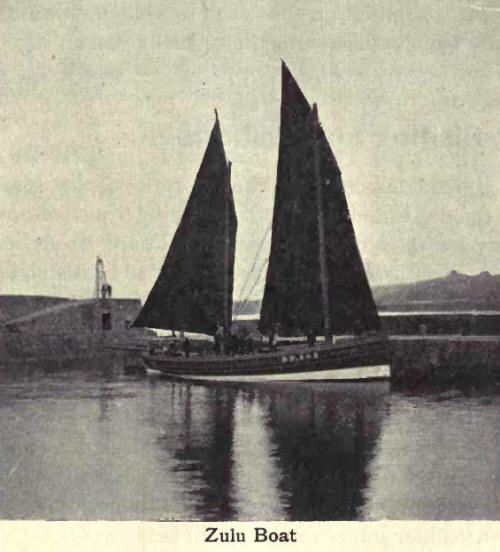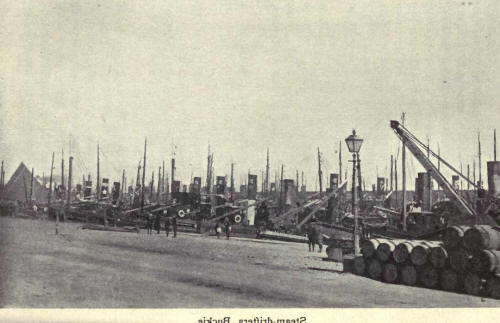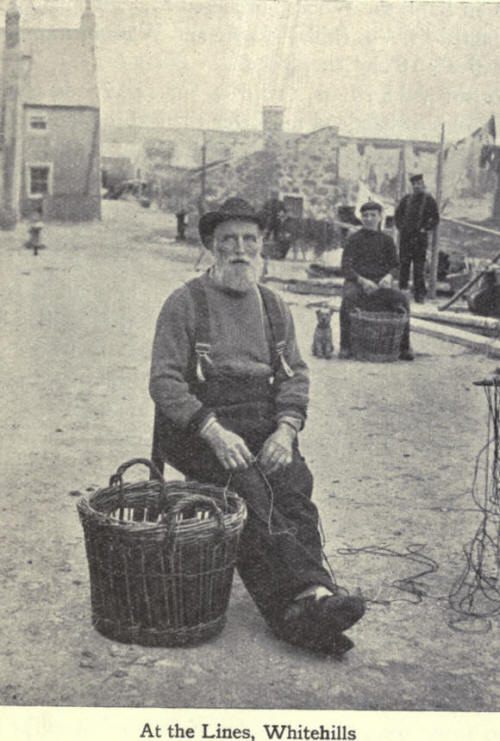Sunday 28 November 2010
Thursday 25 November 2010
Free Range Eggs - All Year Round
Thursday 4 November 2010
History Of Fishing - North East Scotland
It is highly creditable to the enterprise of the fishermen that the line- and the herring-fishing resources of the county are the largest in Scotland. The greatest herring fishery in the world is that prosecuted in Scotland, and in its contribution to that fishery, Banffshire takes the leading place.
Up to 1907 all fishing vessels belonging to Banffshire had a distinctive number which was prefaced by the letters BF. In that year the seaboard was divided into two districts of registration, Banff and Buckie, the fishing craft in the Banff Fishery district retaining the BF designation, while newly acquired boats in the Buckie Fishery district began a fresh register under the letters BCK.
The hey-day of the sail fishing fleet occurred perhaps in the eighties and in the earlier years of the nineties of last century. The Banffshire fleet of that day had a supremacy in numbers and in efficiency that was unchallenged in Scotland. The large white letters "BF" on the broad expanse of the brown sails of the yacht-like zulus were to be seen on every sea around Britain, and their presence was a vital influence in the fortunes of a fishing that was of national importance. Seventy years ago the scaffie, undecked for the most part, was the boat in common use in Banffshire. That type gave way to the Fifie boats, first
built in Fifeshire, while both were displaced by the zulu boat, which for long dominated the position. This type, matchless for sea-worthiness and sailing power, became very popular, and for years a first-class zulu boat was the best equipped and most highly valued vessel in the northern fishing fleet.
The increasing size of these craft and the growing productive power of the trawling industry led to a development in Banffshire that'still holds good. Lines were practically abandoned, and the whole year was devoted to the capture of herrings in all the seas round the British Isles.
The influential part taken in activities of the kind by craft from the county finds fitting illustration in official figures. At the English fishing of 1913, for instance, there took part i 163 Scottish boats, and of these 454 belonged to the county of Banff, while of the total value (£763,256) of fish landed by the Scottish fleet working that season in England, the share of Banffshire boats was £311,384. In the same year, of 159 Scottish boats that worked on the Irish coast, 88 belonged to Banffshire and of the total yield (£40,572) of Scottish boats, the contribution of Banffshire crews was £21,690.
In the early years of the present century another great development was the introduction of steam-power to the fishing craft, and now the county has a larger and more valuable fleet of steam drifters than any other county in Scotland.
The story of progress in the present century reads indeed like a fairy tale. Thus in 1900 the Banff Fishery district had no steam vessel; the Buckie district had three, the value of which, with their gear, was put at £8094. Fourteen years later the number of steam drifters in the county had increased to 398 and their value was put at over one million sterling. At the same time sailing boats decreased in value and in number: in 1900 there were in the Banff district 463 and in the Buckie district 731, figures that nine years later fell to 372 and 443. Since that time the same tendency has increased; and if the prophecy of a Portknockie fisherman may not prove true that the sail boat here may become as much a thing of the past as Caesar's galleys, the trend of the industry is certainly all in that direction. In the meantime the process has been held somewhat in check by the installation in a number of the zulu boats of motor engines and by the provision of other new craft similarly fitted. These vessels, as occasion demands, may use either the wind or the motor. In the year 1913, the year preceding the outbreak of war, when matters were normal, fishing resources in the county were:

That gave a total of 369 steam drifters owned in the county. Irn the same year there were in all Scotland 876 vessels of the type, the county of Aberdeen, with its three Fishery districts of Aberdeen, Peterhead and Fraserburgh, coming next to Banffshire with 272, or fewer than the number owned in the single district of Buckie. Thus in 19! 3 the fishing plant of Banffshire consisted of:
The va\ue that year of fishing plant and gear on the East Coast of Scotland—on the West Coast the figures are negligible—was £4,736,508. Deduct from that the valuation of the fishing plant of Aberdeen, consisting for the most part of trawlers, and we reach a value for the East Coast of 3,506,294. Of that total Banffshire claimed more than one-third: so that its supremacy in potential herring-fishing capacity is unchallenged in Scotland, and we must remember that by far the greater part of these wealthy resources accrued to the county within the previous 14 years, and had been derived entirely from the democratic herring. There is the curious accompanying fact that the herring fishing in the county has declined of late years. No large fleet of boats makes any of the towns its seasonal headquarters, and the landing of herrings at county ports is confined to some extent to week-ends when boats return to replenish their fishing gear or for a general outfit.
The development of the fisheries led to large extension of the boat-building yards in the county and that industry has in consequence reached an important position. In the increase of population it has been reflected most definitely in the parish of Rathven, the headquarters of the fishermen of Banffshire. In 1861 its population was 8240; and in 1911 it was 15,995, so that in the course of fifty years the population was doubled.
In several ways the fisher folk are a race apart. Their difference of dialect has already (p. 48) been noticed. Remarkable, too, is the way their communities have maintained a continuity of family names. In a recent roll of voters, confined to male householders, all fishermen, there were in the quoad sacra parish of Gardenstown 17 Nicols, i g Wisemans, 26 Wests, and 68 Watts. Macduff with a few Patersons and Watts, had 17 MacKays and zo Wests, while in Banff the Woods numbered 27. Two names predominated in Whitehills—Lovie and Watson, numbering respectively 18 and 19.
Portsoy had 8 Mairs, 1.1 Piries, and 14 Woods, while in the hamlet of Sandend no fewer than 26 of the heads of fishermen's families belonged to the great family of Smith. Cullen had 33 of the name of Gardiner and 55 of the name of Findlay, while in Portknockie there were 20 Piries, 24 SIaters, 47 Woods, and 84 Mairs, or 175 heads of families of four names. Findochty went even one better, for it had 182 fishermen householders with four names between them—Campbell 24, Smith 35, Sutherland 39, and Flett 84. In Buckie, east of the Burn, there were 15 Coulls, 29 Jappys, 69 Murrays, ii 6 Smiths, and 128 Cowies, while in the western division there were 23 Coulls, 28 Geddeses, and 47 Reids. In Portgordon there were 21 Coulls, and 32 Reids. The circumstance explains, of course, the habit that is almost universal of having a tee name as well, a name by which the fisherman is more familiarly known than that in which he has been registered. The multiplicity in a small community of instances of the same name makes it not only a convenience but a necessity. How else, among scores of Cowies, of Coulls, of Jappys, Woods and Slaters, many of them of the same Christian name, is one to differentiate? So accustomed are many of them to be recognised only by what may be called their acquired names, that they are addressed, not by their Christian names, but as Johndie, Saners, Pum, Gyke, Dottie, Smacker, Dumpy, Bosan, Cockle, Bo, and so on.
The classic instance that illustrates the point has been told by Mr Joseph Robertson. A stranger had occasion to call on a fisherman in one of the Banffshire coast villages of the name of Alexander White. Meeting a girl, he asked, "Could you tell me far Sanny Fite lives?" "Filk Sanny Fite?" "Muckle Sanny Fite." "Filk muckle Sanny Fite?" "Muckle lang Sanny Fite." "Filk muckle lang Sanny Fite?" "Muckle lang gleyed Sanny Fite," shouted the stranger. "Oh! it's 'Goup-the-Lift' [= Sky-starer] ye're seekin'," cried the girl, "an' fat for dinna ye speer for the man by his richt name at ance?"
Wednesday 3 November 2010
Ros' Recipe For Traditional Scottish Stovies
ROS' STOVIE RECIPE
Stovies Ingredients:
Left over Beef diced up
4 large Tatties partially
boiled and sliced
1 thinly sliced onion
1 tablespoon of dripping from the cooked beef
A wee bit of beef stock
Salt and Pepper
Thursday 21 October 2010
How Close Is The Distillery Pub Speyside Way Etc
Macpherson sword Sought
The five-foot-long medieval-style sword belonged to James Macpherson the freebooter, who was hanged in the town in 1700.
The idea is the latest project of the Banffshire Maritime and Heritage Association.
Legend has it that Macpherson had the title of the ‘Robin Hood of the North’.
He led a band of gypsies, who rustled cattle in the area and seemed too cunning to be caught.
However, Macpherson was finally apprehended by Lord Alexander Duff of Braco at St Rufus Fair in Keith, and brought to the jail in Banff.
He was tried at the town’s sheriff court and found guilty of being a thief.
A keen fiddle player, Macpherson is said to have written a tune titled Macpherson’s Lament or Rant.
On the day of his execution, he was taken to the gallows in Low Street and, as a last request, he played his tune and then offered his fiddle to the crowd, but no one dared to take it as Lord Braco was present, and they feared they would be associated with the outlaw.
Macpherson then broke it over his knee. A reprieve was said to be on his way to pardon Macpherson and when Braco heard of this he put the town clock in Banff forward by 15 minutes to make sure Macpherson was hanged.
Now the Banffshire Maritime and Heritage Association have had a replica constructed to see if the original can be found.
Stanley Bruce, secretary with the group, said: “We arranged for Stanley Smart, a blacksmith in Aberchirder, to construct the sword.
“It was said that Lord Braco took his sword and placed it in the armoury at Duff House, however it’s not there anymore.
“We hope the replica will make someone come forward with the original and it can go to Banff Museum, and the replica to the Clan Macpherson Museum in Newtonmore. In the meantime, the replica will stay at Banff Museum,” said the heritage group secretary.
Robert Taylor from Peterhead turned the handle and DJR Water Jetting in Oldmeldrum cut the blade.
Mr Bruce added: “We are grateful to all the people who help construct the sword as they gave their time for free.”
Friday 15 October 2010
Private Collection Of 400 Whiskys
The Dark Art Of Whisky Blending
How To Drink Blended Whisky
Thursday 14 October 2010
RAILBUS ON THE OLD SPEYSIDE LINE
Speyside Distilleries
Wednesday 24 February 2010
Boiler Blues
Murphy's Law
If a boiler is going to breakdown it is going to do it on one of the coldest nights of the year.

Fortunately we didn't have guests in (closed for re-decoration) and also fortunately we have insurance to cover such eventualities. Major repairs are being carried out this morning without costing us a penny
It still begs the question why a new boiler, supplied and fitted by British Gas (and maintained under contract) needs such major repairs less than 5 years after installation
Any other B&B owner take heed . . .get insurance to cover the repairs and also to cover loss of business. We adopt a belt and braces approach with back-up systems in place (hot water and heating) but I'm sure many smaller establishments haven't thought about the possibiliy of major breakdown of either hot water, heating, or in the case of Gas both.
Wednesday 20 January 2010
PDF Brochures
I have just uploaded 3 brochures which will be of interest to anyone visiting Speyside
1. Gordon & MacPhail
2. Aberlour Walks
3. Speyside Cooperage
I hope to add more over the coming weeks
Out At Last

We Had 4 ft of snow in Aberlour
After 4 weeks of deep snow I finally dug to car out and took a run over to the coast. It was very cold on the beach but nevertheless nice to get out of the house and into the fresh air

AFTERNOON SUN REFLECTED ON BEACH POOLS
Decorating Season

January is a quiet month, so time for Ros to get her paintbrushes out. This year we are decorating our 2 family rooms and the dining room. After two weeks of hard work everything will be finished for Friday 22nd January when we open for the 2010 season.
We are currently working on our Spey Fishing packages, combining Diner Bed & Breakfast at Norlaggan with a weeks salmon fishing on the River Spey. The first week will be 14th February (a few days after the start of the Salmon Season) and until the end of march a weeks fishing, with accommodation and evening meal will be £360 per person (based on 2 people sharing a double or twin room).
We will be posting further information here and on our web site . . in the meantime if you are interested please email admin@norlaggan.co.uk






.jpg)

